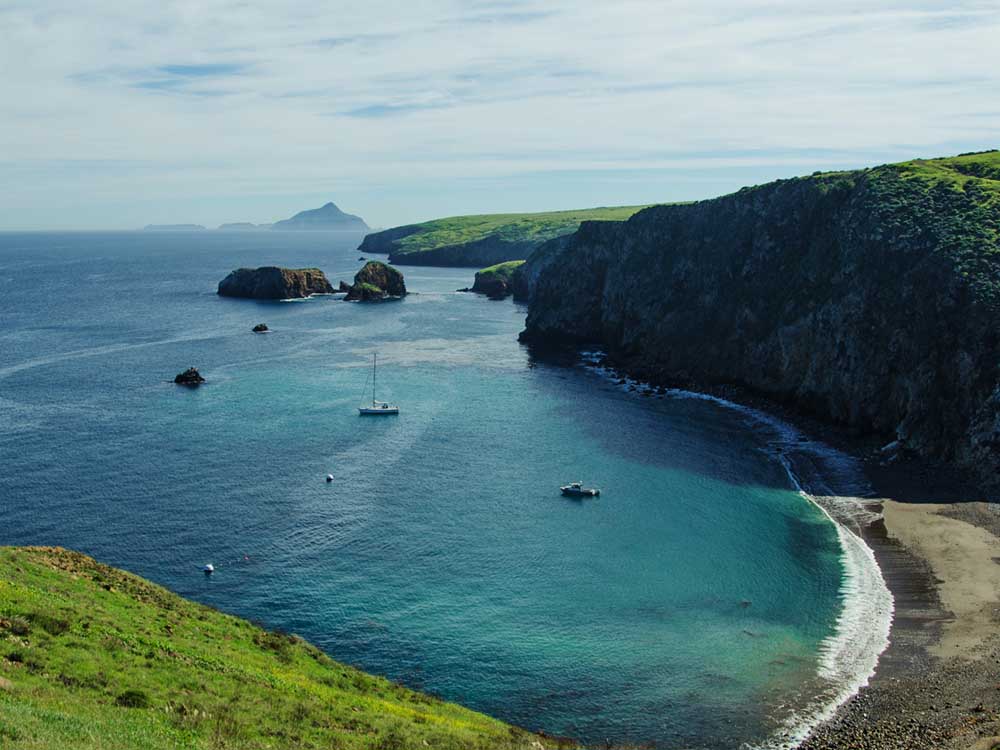Life and death in the Channel Islands
Published 12:00 am Sunday, May 17, 2015

- Barb Gonzalez / For The BulletinRemarkable in its serenity, Scorpion Anchorage once served only the historic Scorpion Ranch on eastern Santa Cruz Island. Today campers and kayakers visit this beach, while others continue to rocky Anacapa Island, on this photos horizon
{%comp-FFFFFF-bl%}
OXNARD, Calif. —
In the wilderness, it turns out, beauty and cruelty are not so far removed from each other as one might like to think.
That’s as true in a wilderness of water, where most human visitors don’t see more than a few feet beneath the waves, as it is in mountains or forests or rocky coastlines. It is certainly true in one of the more isolated national parks in the Lower 48, Southern California’s Channel Islands National Park.
Dozens of schoolchildren were witness to the capricious ways of nature this year, during a 21-mile crossing of the Santa Barbara Channel — between Oxnard’s Channel Islands Harbor and the historic Scorpion Ranch, main portal to the largest island of the group, Santa Cruz Island. {%pr-3849544%}
Photographer Barb Gonzalez and I were with them one idyllic morning aboard the Islander, a tour boat operated by park concessionaire Island Packers. It gently rolled in the ocean swells as the channel’s prolific marine life staged a show for which Sea World has no parallel. Two gray whales spouted in the near distance, their blow clearly visible above the horizon. A synchronized symphony of dolphins danced upon the waves on all sides of us.
Someone sighted two orcas, or killer whales, directly ahead. Their distinctive black-and-white markings were unmistakable.
I was impressed by the immense power they used to hurl their 4,000-pound bodies through the surf in unison, in their constant search for food.
The schoolchildren, enjoying a field trip with their third- and fourth-grade classes, squealed with delight to see a young sea lion following along beside the boat. The sea lion’s whiskered mug glanced up at them and seemed to smile and nod approval as it continued on its course, moving ahead of the Islander.
But the children and other cruise passengers weren’t the only ones following the sea lion’s movements. The orcas also took notice. {%pc-3849540%}
As the kids looked on, horrified, the young sea lion became fast food. The orcas covered 100 yards of ocean more rapidly than an Olympic sprint champion. In seconds, a mere whirlpool had replaced a happy pinniped. It was a classic case of survival of the fittest, and speed and strength had played their trump card.
A couple of little girls were in tears. A few of their male counterparts high-fived. But all had learned a harsh lesson about the food chain and the constant cycle of life and death to which all living creatures are subject. I hope their teachers later took the opportunity to build a lesson upon it.
Unique isles
Isn’t this one of the reasons that we so highly value our national parks? Since the time the National Park Service was established in an increasingly more urban America in 1916, there have been few better opportunities for city people to be thrust face-to-face with life in the wild — where nature makes no apology for throwing its naked truth, often but not always beautiful, on a primitive canvas for all to see.
Established in 1980, Channel Islands National Park consists of the islands of Santa Cruz, Santa Rosa, San Miguel, Anacapa and Santa Barbara, which parallel the Santa Ynez Mountains. Although protected as a national monument since 1938, only later were the islands accorded national park status and their surrounding waters declared the Channel Islands National Marine Sanctuary. (Three more southerly islands — San Nicolas, San Clemente and well-populated Santa Catalina — are not within park boundaries.)
Isolated from the North American mainland since prehistoric times, these semiarid islands are home to more than 140 species of plants and animals that live nowhere else on earth. Evolution has proceeded independently of the adjacent California coastline.
Spanish galleons sailed this coast in the 16th and 17th centuries. Explorer Juan Rodriguez Cabrillo, the first European to set foot in California, is believed to have been buried on San Miguel Island. And native Chumash Indians were no strangers to these shores: There is ample archaeological evidence of human habitation 13,000 years ago. But the Chumash population vacated the islands for mainland missions by the 1820s. {%pl-3849556%}
Beginning in the late 1830s, land-grant ranches were established by Mexicans and Americans on the three larger islands of Santa Cruz, Santa Rosa and San Miguel. With the settlers came their livestock: thousands of sheep, along with cattle, pigs and horses. They devastated the grasslands and drove many unique species to the brink of extinction.
As environmental awareness increased in the 20th century, and with help from captive breeding programs, wildlife began making a recovery. Sea otters, elephant seals and white abalones are protected by law; brown pelicans and bald eagles have re-established colonies; three subspecies of island foxes, whose population had dropped to 15, are living freely on the three main islands; and nearly all livestock and feral pigs have been removed or eliminated.
Day hiking
Island Packers has served all five of the national park islands since 1968. Campers, hikers, kayakers and snorkelers in search of solitude will find it here, especially on foggy, windy San Miguel Island; on tiny, out-of-the-way Santa Barbara Island; and along the rocky 5-mile spine of Anacapa Island, once a mariners’ nightmare. Santa Rosa Island, 15 miles long and 10 miles wide, was the site of the Vail and Vickers Ranch, where a visitor center now sits beneath rare Torrey pines, beside Bechers Bay. {%pc-3849550%}
There are ranger stations on all five of the islands but most notably on Santa Cruz, where I disembarked. This is the best choice for a first visit to the Channel Islands. The historic Scorpion Ranch house, built in 1887 and the center of livestock operations until acquired by the National Park Service 90 years later, is now an interpretive museum, and it’s surrounded by other ranch buildings, including a bunkhouse and storage shed. A quarter-mile away, near the primitive campground, remnants of a hand-dug 19th-century water system add to the historic intrigue.
Day visitors, who may have five hours on the island, are wise to spend most of their time hiking. As California’s largest island (24 miles long and up to 6 miles wide, capped by 2,450-foot Diablo Peak), Santa Cruz claims more than 60 endemic species, including its fox and its one-of-a-kind island scrub jay. Although a majority of Santa Cruz is owned and strictly managed by the Nature Conservancy, dozens of miles of trails to spectacular viewpoints are readily accessed from the Scorpion anchorage. {%pl-3849561%}
Gonzalez and I set out for Cavern Point and wound up at Potato Harbor, covering about 5 miles of moderate terrain. Serenaded by two jays and another small bird we couldn’t identify, we climbed a 400-foot ridge that ascended steeply above the ranch, then continued on a bluff-top trail to Cavern Point — so named for the large sea cave at its foot. We let our gaze settle upon the surf, crashing below upon stark cliffs to our east and west, and surveyed the horizon in search of whales.
Seeing none, we ventured along a less well-trodden path that followed the plateau west. It eventually merged with an old Jeep road that came to an end atop Potato Harbor. Here we sat to enjoy a lunch of sandwiches, fruit and bottled water overlooking this serene inlet, its turquoise waters cupped within cliffs as if by two hands.
There’s no trail down to the water here, however, so we returned to the Scorpion Ranch in plenty of time for the return cruise to Oxnard. {%pf-3849564%}
Harbor side
Oxnard’s Channel Island Harbor is a pleasant enough place for a stroll, before or after an island excursion. A paved walk, suitable for bicycling or strolling, slices between Harbor View Park and the masts of myriad sailing vessels. Several of the area’s best restaurants are located here, including The Waterside Restaurant & Wine Bar and Moqueca Brazilian Cuisine, both in the same Marine Emporium Landing area as the Island Packers’ launch.
The harbor’s leading attraction is the Channel Islands Maritime Museum, whose collection ironically has little or nothing to do with the islands themselves. Exhibited here are historic paintings of seascapes and classic sailing vessels — 17th-century Dutch masters, 19th-century French impressionists — along with shipwreck artifacts and more than a score of intricate models, ranging from a Chinese Ming Dynasty treasure ship to exotic soup-bone models carved by Napoleonic War prisoners.
Downtown Oxnard, about 3½ miles inland from the harbor, doesn’t have a lot to impress this visitor. The Henry T. Oxnard National Historic District — named for the city’s founding father, who made his fortune on sugar beets — comprises about six square blocks of private homes in craftsman bungalow and Spanish colonial styles. Nearby, the neoclassical Carnegie Art Museum displays ever-changing exhibits of modern California impressionism and Latino art. {%pr-3849592%}
Heritage Square, three blocks southeast of central Plaza Park, displays more than a dozen historic homes, built between 1877 and 1912, moved here from other locations around Ventura County and restored to their original condition. Guided tours are offered on weekends, but self-guided tours are always an option — along with visits to the square’s restaurants and winery.
In all, this city of more than 200,000 has four wineries, an integral part of the Ventura County Wine Trail. My favorite is the Herzog Wine Cellars, located in an industrial park on Oxnard’s east side. The kosher establishment incorporates the Tierra Sur restaurant, which presents farm-to-table specialties with top-end service in a magnificent dining room.
Much of the Oxnard area remains agricultural. John Lennon might well have written about its surrounding strawberry fields, which seem to stretch forever in all directions. That season is celebrated each May at the California Strawberry Festival. Other events, such as the Salsa Festival in July and the Tamale Festival in December, are favorites of the region’s Latino residents.
Ventura and Ojai
Although the county seat of Ventura has half the population of Oxnard, it is a more vibrant community. Indeed, when I asked Oxnard residents where they went to eat and drink, they invariably suggested that I head to this town, 8 miles northwest. {%tl-BDBDBD, 000000, 2%}
Once a thriving Chumash community, Ventura has a modern history that dates from 1782, when Franciscan Father Junipero Serra founded the Mission San Buenaventura. Restored in the 1950s and ’70s, the mission is a major point of interest today. Another is the Olivas Adobe, built in 1841 and now the site of living-history re-enactments.
A highlight of downtown Ventura is the 1928 Majestic Ventura Theater, an art deco concert venue where bands from The Doors to Van Halen to the Red Hot Chili Peppers have performed. There’s also a historical marker at California and Main streets, outside the “law offices” of Perry Mason, a fictional attorney of the 1950s and ’60s created by resident author Erle Stanley Gardner.
Ventura County bridges the geographical gap between Los Angeles County, to the southeast, and Santa Barbara County, to the northwest. Of its eight inland towns, none is as well-known as charming Ojai (pronounced “OH-hi”), whose 7,500 people live about 15 miles from the coast.
Tourism here is geared to outdoor recreation (mainly hiking and bicycling) and spiritual retreats attended by luxurious boutique hotels and organically oriented restaurants. To stimulate local small businesses, the city council has prohibited chain stores other than a few gas stations.
If urban environments were seeking a model like the Channel Islands to encourage spiritual health, maybe Ojai would be a good place to begin looking.
— Reporter: janderson@bendbulletin.com.
{%pf-3849533%}







